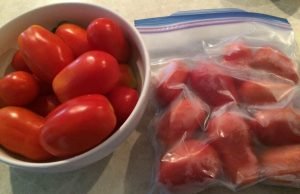It has rained all day, every day for a week now and the sky has run itself out of water! I stole this break in the rain to check on sown seeds and the herbs and berries.The back half of this box is mixed lettuces and the front left is daikon radishes. The front right is leftover bibb lettuce from a Victory Garden project at my son's school.The tomatoes and peppers are hardened off and ready to be planted in the beds. I have my own saved seed serranos as well as an heirloom yellow pepper this year and for tomatoes I am growing an heirloom grape tomato and trying my first F1 hybrid for a red slicing to improve yield.The blueberries are trying to live up to their names with a hint of purple starting to stand out against the green.The sage flowers have been a favorite of visiting bees but are ready for their spring pruning now.The chives are also sporting lovely dead head flowers and at last they seem to be truly established in my garden.Soggy but smiling!
Read MoreChicago City Farm - Field Trip
I arrived in Chicago yesterday for an annual conference with a few hours to spare so I took the opportunity to go see City Farm in person! I have been looking forward to seeing this fantastic piece of urban farming/city renewal since I wrote about it in January, unfortunately the three days I am here are the three days they are closed to the public. Undeterred, I figured i could at least view it from the outside and see how the new location at W Division Street is coming along.The very warm, but tired Farm Director, Meredith, saw me taking pictures and came out to chat with me. Despite being at the farm since 5 am picking produce for the Farmer's Market, she gave me a micro-tour and we chatted about growing food.The lot looks even bigger in person and wraps north and east sides of the Chicago Fire Department building - the brick building to the right.It could not have been a more beautiful day to visit.Meredith was very excited about the tractor that will help the workers and volunteers accomplish more on this sprawling lot.It is wonderful to see young people engaging in a type of agriculture that doesn't just build farms, it builds communities. If you are ever in Chicago, preferably Wednesday-Saturday make this a must-visit!
Read MorePomodori Aplenty
I had my largest one-day harvest of Roma Tomatoes at a little over 3.5 lbs, a similar weight in Amana Orange and Mortgage Lifter Tomatoes were ready to be picked along with some cherry tomatoes, a nice bowl of figs, more black eyed peas to add to the jar and four more cobs of Glass Gem corn.I can't get over how pretty and varied the glass gem cobs are, each seems to have their own color theme.I have at least 5 more cobs to harvest and I can't wait to see their variations!
Read MoreMulligan Fire Roasted Cherry Tomato Salsa
A few weeks ago I finally had enough cherry tomatoes to give the Fire Roasted Cherry Tomato Salsa recipe I wrote about in February a whirl. The cherry tomatoes I had in abundance were two varieties of yellow tomatoes and I thought that would work nearly as well as the red. I was mistaken.The salsa was flavorful and had the perfect amount of heat, but without the red tomatoes it lacked the acidic tang this salsa needed to balance the sweetness of the fire roasted onions.So last week I tried again with farmer's market red cherry tomatoes.The kitchen smells unbelievably good during and after the fire roasting step!And the finished product!The mulligan Fire Roasted Cherry Tomato Salsa was delicious and I will need to rethink my yellow/red cherry tomato planting ratio for next year.
Read MoreImma Be - Black Eyed Peas In the Garden
So maybe the July garden isn't classically beautiful, but it does have a quirky beauty...While bolted lettuce is a tall, straggly creature on its own, the Tom Thumb lettuce is also a bit elegant against the backdrop of collards:The glass gem corn is doing incredibly well (note, strawberry popcorn is not nearly so prolific):The blueberries are abundant this year:The figs, while still green, are also abundant this year:The asparagus is still throwing up occasional spears:And the tomatoes...all those tomatoes!But the star of the late July garden for me is my first ever harvest of California Black Eyed Peas! These cowpeas were planted to fix nitrogen for the corn they are growing next to and up, but now that I am seeing the beginning of what looks to be a good harvest I am excited about them for their own sake:
Read MoreJuly Garden Update
Under the best of circumstances July is an awkward time for the garden.Spring greens (spinach, lettuce, cilantro) still in the garden have bolted or browned, strawberries have stopped producing anything but dozens of straggly runners and asparagus has transmogrified into its less known, fuzzy small tree form. Between these only-a-mother-could-love-them beauties are the bare spaces where sugar and snow peas and pak choy have been removed but it is still too early to sow fall plants, July may be the worst time to have a garden guest.I have a garden guest coming next week.The wonderful REALTOR that patiently waited and watched while I stood in potential back yards mentally calculating full sun hours and painstakingly measuring for raised beds that were at the time, stored in a rented garage, is coming to see what I "have done with the place" and late July is the date we picked for dinner and a garden tour.This post is half garden update, half convincing myself that there are still beautiful things to be seen even in this straggly season. Here goes:The blackberries are huge and I should still have a good mix of ripe and unripe next week.I always overseed plants like basil so I can use the thinnings on meals while letting the main plants mature.There is only one butternut squash on the vine so far, but many blooms.I picked my first round of Envy edamame with only a handful left in the garden, but I had left the wonderful nitrogen fixing plants in the garden as companion plantings to everyone else.And the rest of this story is tomatoes, the beauties of summer. These are some of the Blue Cream Berries cherry tomatoes before they ripen and take on that creamy yellow color.The roma tomatoes are thick on the vine and ripening at a steady rate.A pretty average harvest day with a double handful of roma tomatoes, a couple of Mortgage Lifters, a bowlful of Hartman's Yellow Gooseberry cherry tomatoes (the most prolific and tallest of my cherry tomato plants this year) and my first Black Beauty zucchini of the year.Here's hoping she really likes tomatoes ;)
Read MoreRoma Wasn't Built In a Day
Roma math:A decent batch of homemade tomato sauce with enough to freeze or can for future use requires a minimum of 15-20 lbs of roma tomatoes.The average day on the urban farm (with 16 roma tomato plants in high season) results in anywhere from 1-3 lbs of roma tomatoes.I struggled with this math last year as I watched ripe romas edge toward over-ripeness while waiting for enough companions to be ready at roughly the same time to make a batch of sauce. Out of desperation I started searching "freezing whole tomatoes" and low and behold:Not only CAN you freeze whole tomatoes, there are a couple of benefits to doing it. Freezing, especially for short term storage doesn't have to be particularly fussy. Just clean, pop in a bag, remove most of the air and voila - a partial batch of sauce! Also, when frozen tomatoes are thawed to make sauce, the skins just slide right off, saving the blanching step.
Read MoreFood With a Story - Mortgage Lifter
When was the last time you ate a tomato and considered the intrigue and controversy surrounding it's provenance?This big guy, sold by Baker Creek under the name Mortgage Lifter is almost ready to harvest and when I save the seeds after enjoying my first taste of this storied heirloom fruit, I will be thinking of the dueling stories of where it originated. A little food for thought ;)
Read MoreTowering Tomatoes
The view standing next to my Hartman's Yellow Gooseberry Tomato.The view a few steps back. This tomato plant has already over taken the 8 foot bamboo support pole and I need a step ladder to access the top with many months of growing still ahead. Watch out Charles Wilbur...
Read MoreFinally Spring - Garden Update
The average last frost date for this area has come and gone and the lowest nighttime temp forecast through the end of the month is 41. I think spring is finally here to stay!The French Breakfast Radishes are speeding toward their 25 days to maturity and the Lollo De Vino Lettuce is by far, the prettiest lettuce I have ever grown.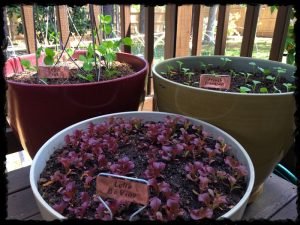 The strawberries are already thickly covered in blooms and green berries.
The strawberries are already thickly covered in blooms and green berries.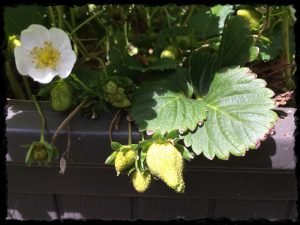 And speaking of "thick", the June-bearing variety I have put out an outrageous number of runners. I tried to stay on top of it last year, giving away dozens of rooted starts and adding many more to the compost bin, but they still managed to do a little guerrilla gardening of their own, sneaking out some late season runners to plant offspring around the designated 4'x8' beds.
And speaking of "thick", the June-bearing variety I have put out an outrageous number of runners. I tried to stay on top of it last year, giving away dozens of rooted starts and adding many more to the compost bin, but they still managed to do a little guerrilla gardening of their own, sneaking out some late season runners to plant offspring around the designated 4'x8' beds.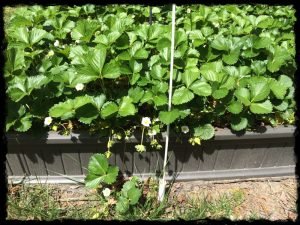 The blueberry bushes are also covered in unripe berries and continuing to bloom. This is their second summer in place and I am hoping the January pruning results in even larger, more plentiful berries than last year.
The blueberry bushes are also covered in unripe berries and continuing to bloom. This is their second summer in place and I am hoping the January pruning results in even larger, more plentiful berries than last year.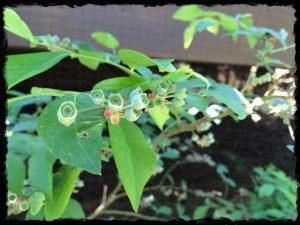 I am growing 2 varieties of Sugar Snap Peas this year, finishing out the last of my Sugar Anns and also growing a variety call simply Sugar Snap.
I am growing 2 varieties of Sugar Snap Peas this year, finishing out the last of my Sugar Anns and also growing a variety call simply Sugar Snap.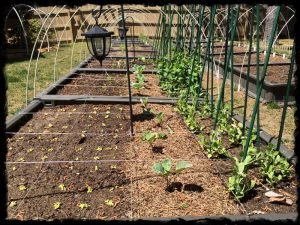 The collards and lettuces in the garden are off to a slow start which I attribute to the mostly cooler weather we have had this spring. With daytime highs starting to reach into the high 70s and low to mid 80s, I think their growth rate will pick up quickly in the next few weeks.And last, but never least, the tomatoes.
The collards and lettuces in the garden are off to a slow start which I attribute to the mostly cooler weather we have had this spring. With daytime highs starting to reach into the high 70s and low to mid 80s, I think their growth rate will pick up quickly in the next few weeks.And last, but never least, the tomatoes.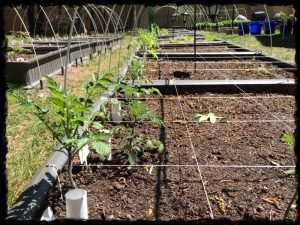 Of the 38 tomatoes that were emancipated at the end of March, I have 37 that are doing very well. The septoria leaf spot has dramatically slowed in it's progression since they were moved outside and the one Rebekah Allen tomato plant that was lost to a nighttime nibbler, has been reseeded indoors and will be replaced outdoors in a month or so.This weekend I will be sowing more herbs in the front and reseeding some of the spinach that has had less than stellar germination rates this year."In the spring, at the end of the day, you should smell like dirt." ~ Margaret Atwood
Of the 38 tomatoes that were emancipated at the end of March, I have 37 that are doing very well. The septoria leaf spot has dramatically slowed in it's progression since they were moved outside and the one Rebekah Allen tomato plant that was lost to a nighttime nibbler, has been reseeded indoors and will be replaced outdoors in a month or so.This weekend I will be sowing more herbs in the front and reseeding some of the spinach that has had less than stellar germination rates this year."In the spring, at the end of the day, you should smell like dirt." ~ Margaret Atwood
Last Frost Date
Last night was a low of 28 so the tomatoes were covered (again) and I am optimistic that it was the last night of freezing temps (again). This time, at least, I have the Average Last Frost Date in my corner...though average and last possible vary by over a month.I the meantime, the container garden on my deck planted with cold weather crops is just fine with or without a light frost. The beautiful colors and daily growth of of these varietals make warmer weather feel not so far away.This is my first year growing Lollo De Vino Lettuce. I had run out of room in the garden for another lettuce but it was just to pretty to resist when I ran across it so I am growing it in a container along with a volunteer cilantro. Another first year variety, the French Breakfast Radishes have sprouted.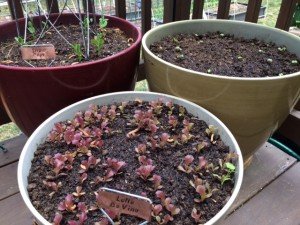 I planted Snow Peas in the container garden this year to add some height contrast to the low growing lettuce and radishes. The easy access to peas and shoots is a total bonus.Today's cold weather task is to give some overdue attention to the indoor basil garden which needs some pruning and thinning.Happy Average Last Frost Date (for Raleigh NC)!
I planted Snow Peas in the container garden this year to add some height contrast to the low growing lettuce and radishes. The easy access to peas and shoots is a total bonus.Today's cold weather task is to give some overdue attention to the indoor basil garden which needs some pruning and thinning.Happy Average Last Frost Date (for Raleigh NC)!
Avant Garden
The single, yellowed leaf I found on one of my paste tomatoes at the end of February was actually the opening shot of a fungal tug-of-war that will likely continue for the whole of 2016's growing season. The Septoria Leaf Spot fungus which can cause damage to tomatoes by defoliation leading to sunburned fruit has been mostly contained by removal of affected leaves and regular use of a homemade organic fungicide (1 gallon of water, 2 TBS vegetable oil and 2 TBS baking soda) but the close proximity of the plants to each other while they are stuck in my indoor grow room was almost certainly encouraging the spread of the fungus.With about a week to go before the last frost date for my area, I have been obsessively checking the 15 day weather forecast for the past few days to determine whether I could risk putting the tomatoes out a little early to give them some much needed space, fresh breezes and sanitizing sunshine to inhibit the fungus from spreading. Today I rolled the dice and moved them to the great outdoors!The PVC tubes that my bamboo tomato supports fit into are already in place so the plant roots will not be disturbed later in the season when they are necessary and the tomatoes have been hardened off.Last year I had a handful of tomatoes that had blossom end rot so I saved eggshells all winter and crushed them into a powder to provide more calcium to the plants. Tomatoes are a vine plant that will root along their stem, so mine were laid down in the channel I dug rather than placed upright. Eggshells were spread beneath and on top of the root area.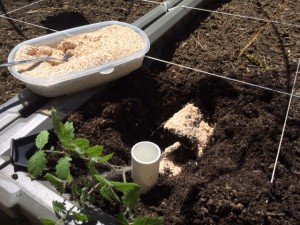 The stem is gently bent at a 90 degree angle several inches up from the top of the soil line from the starter cup. Roots will develop along this stem and according to Charles H. Wilbur, more roots will result in more tomatoes.
The stem is gently bent at a 90 degree angle several inches up from the top of the soil line from the starter cup. Roots will develop along this stem and according to Charles H. Wilbur, more roots will result in more tomatoes.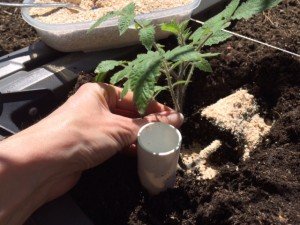 Soil is patted down over the tomato root and around the bent stem and any leaves touching or near ground level are removed to avoid splash up from the soil leading to new and exciting fungal infections.
Soil is patted down over the tomato root and around the bent stem and any leaves touching or near ground level are removed to avoid splash up from the soil leading to new and exciting fungal infections.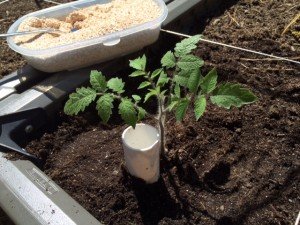 Repeat 37 more times then relax and start compiling fabulous tomato recipes like this one while you wait for the fruits of summer to appear!
Repeat 37 more times then relax and start compiling fabulous tomato recipes like this one while you wait for the fruits of summer to appear!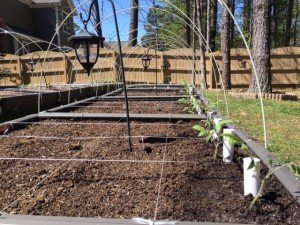
Flavor Bases From Around The World In Less Than 2 Minutes!
Then There Was One
This morning I did my final pass thinning the tomatoes, peppers, collards, cabbage and kale down to a single plant in each starter cup and then I crossed my fingers that no fungi or pests find my singletons between now and when they move outside.For now the 38 tomato plants are vigorous and hale and I am excited that fully half of them are from my own saved seed.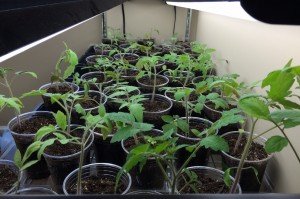 I added a few new varieties this year of both slicing and cherry tomatoes and plan to save seed from all I want to grow again next year.The cabbage and collards are nearly ready to be hardened off and will join the lettuce, spinach and leeks I will be direct sowing this weekend.
I added a few new varieties this year of both slicing and cherry tomatoes and plan to save seed from all I want to grow again next year.The cabbage and collards are nearly ready to be hardened off and will join the lettuce, spinach and leeks I will be direct sowing this weekend.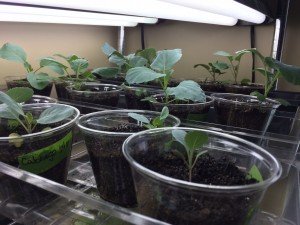 Now that the 2 week forecast has no nighttime temps below freezing it is time to get the spring garden into full swing!
Now that the 2 week forecast has no nighttime temps below freezing it is time to get the spring garden into full swing!
Don't Blink
During the past week of business travel my indoor plant starts have grown with the vigor of youth into a verdant and slightly unruly bunch of tweens.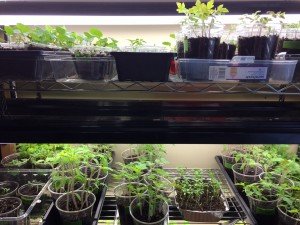 The tomatoes from my saved seed are particularly in need of thinning. I seeded them a little more thickly since I did not know what my germination rate would be. While they initially lagged about week behind fermented seeds I purchased this year, the germination rate for my saved seed looks to be close to 100%.
The tomatoes from my saved seed are particularly in need of thinning. I seeded them a little more thickly since I did not know what my germination rate would be. While they initially lagged about week behind fermented seeds I purchased this year, the germination rate for my saved seed looks to be close to 100%. Pro Tip - always use scissors to snip off the plants you are thinning to avoid disturbing the roots of chosen specimen.
Pro Tip - always use scissors to snip off the plants you are thinning to avoid disturbing the roots of chosen specimen.
Tender Beginnings
While winter is having it's (hopefully) last hurrah outside, I am prepping my indoor garden to be without me for a week while I travel for work.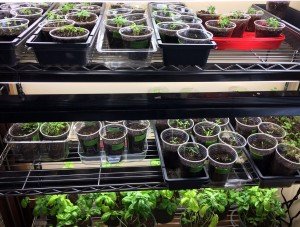 After trying first newspaper pots then peat pots for last year's starts and having them disintegrate before I was ready to transplant to the garden, this year I am using Siloé Oliveira's technique of drilling holes in smooth plastic cups that can be reused year after year.All of my starts are doing well but the ones I am happiest about are my saved seed from the Paste and Amana tomatoes I grew last year. They sprouted a few days behind the new varieties I purchased seed for this year, but since I did not ferment the saved seed I knew they would lag a bit.
After trying first newspaper pots then peat pots for last year's starts and having them disintegrate before I was ready to transplant to the garden, this year I am using Siloé Oliveira's technique of drilling holes in smooth plastic cups that can be reused year after year.All of my starts are doing well but the ones I am happiest about are my saved seed from the Paste and Amana tomatoes I grew last year. They sprouted a few days behind the new varieties I purchased seed for this year, but since I did not ferment the saved seed I knew they would lag a bit.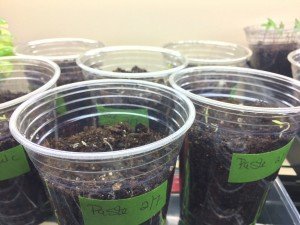 And gratuitous pics of some of the collards and other tomato varieties starts just because they are so pretty...
And gratuitous pics of some of the collards and other tomato varieties starts just because they are so pretty...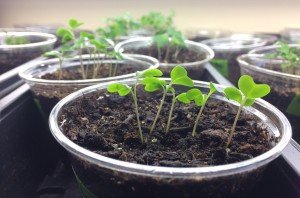
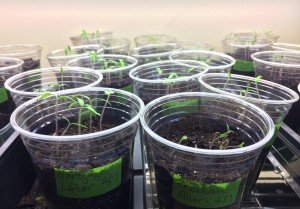
Starting My Garden Early
While Punxsutawney Phil and the meteorologists work out their differing predictions for the end of winter, growers are already hard at work preparing for spring, summer and fall.January plant starts included cabbage,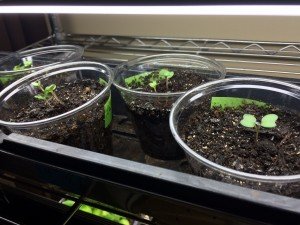 chili peppers, bell peppers and rosemary.
chili peppers, bell peppers and rosemary.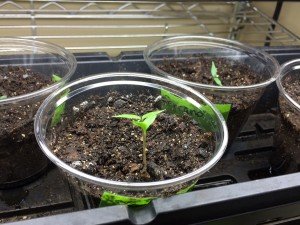 Now that February has begun, the seed starting kicks into high gear with oregano, collards and lots and lots of tomatoes with 8 varieties and a total of 38 plants this year!
Now that February has begun, the seed starting kicks into high gear with oregano, collards and lots and lots of tomatoes with 8 varieties and a total of 38 plants this year!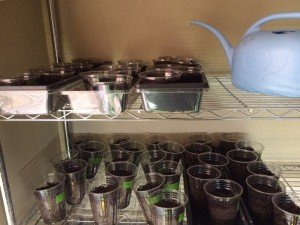 The new starts will welcome roommates in my growing nook for the cilantro and basil I grow indoors each winter. I purchased inexpensive shop lights, metal wire shelving units and florescent tubes 5 years ago so I never have to go a grey winter day without their bright colors and fresh flavors complimenting meals.
The new starts will welcome roommates in my growing nook for the cilantro and basil I grow indoors each winter. I purchased inexpensive shop lights, metal wire shelving units and florescent tubes 5 years ago so I never have to go a grey winter day without their bright colors and fresh flavors complimenting meals.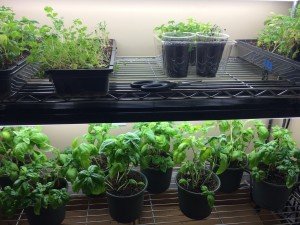 The minimal, initial investment for the equipment has more than paid for itself already and now as my garden diversifies and the number of indoor starts continue to expand each year with no additional infrastructure costs to date, I consider this money extremely well spent.Happy Spring, whenever it comes :)
The minimal, initial investment for the equipment has more than paid for itself already and now as my garden diversifies and the number of indoor starts continue to expand each year with no additional infrastructure costs to date, I consider this money extremely well spent.Happy Spring, whenever it comes :)
New Year's Resolutions (Then and Now)
For 2015 I set two gardening goals for myself - begin keeping a garden log and saving seed and I did pretty well on both of them. My 2015 garden log ended the year with 8 typed pages and containing details from pounds of tomatoes and serranos harvested to the date of the first and last blueberries. I used Word for Mac so I can keyword search in 2016 (and beyond) if I want to find when I planted the 3rd crop of edamame or when my squash and cucumbers were invaded by cucumber worms. I found I was more diligent about doing entries if I kept the document open on my second monitor at all times so when I began the 2016 garden log earlier this month detailing all the indoor starts for January, I continued with this practice.Prior to 2015, I had only saved my own cilantro/coriander seed and purchased everything else. At the end of 2015 I had saved 10 different varieties of everything from squash and chili peppers to flowers and tomatoes. My seed box, which has always been full of Baker Creek Heirloom Seeds packages is now peppered with the plain brown paper envelopes that I use for my own seed.For 2016 my two goals are saving even more of my own seed and mulching. Going from 1 to 10+ varieties that I saved seed from in 2015 is good, but I am growing over 53 annual varieties in 2016 so there is plenty of room to continue to improve in this goal.The Square Foot Gardening method I use places a heavy emphasis on compost but almost none on mulching. The SFG method recommends starting with a 33% compost mixture in the raised beds and continually adding compost as plants are removed and new plants added to each individual square foot, but no mention of covering the soil between and around plants. Soil science as well as observation have led me to understand that just as nature abhors a vacuum and will swiftly fill it, soil abhors being exposed and will cover itself with weeds if it must to protect it from the wind and the sun, allowing it to retain water better and reduce erosion.So for 2016 I will be experimenting with different types of mulches in my beds to see what works best, doesn't invite too many visiting pests and makes the plants and soil happy and healthy.Here's to getting better every year! #Kaizen
The Expat Starter Garden
A dear friend is moving south of the border to live on the shores of Lake Chapala, said to have the second best climate on earth, behind only Atenas, Costa Rica. She wants to start a small garden there and was looking for suggestions.All of these suggestions do very well in both containers (both patio and raised bed) and in rich garden soil, making them versatile, low maintenance choices for a first time gardener.If you are only going to grow one thing, I think basil is a great place to start. It is easy to grow, abundantly productive and can be added to almost every meal you make or have for takeout. I prefer the sweet genovese varieties.If you are only going to grow two things, then basil and cilantro are my choices. Again, easy, abundant and can add a bright taste to any dish, homemade or otherwise. For warmer climates (mine included) try a slo bolt variety.Oregano and rosemary are also low maintenance but useful and abundant herbs for a first time gardener and experienced cook.If she wants to expand beyond herbs, spinach is a great choice for novices. Leaves can be taken as needed allowing the plant to continue growing, many fresh or cooked uses and easy to grow. Again, with warmer climates, a slo bolt variety would be best.After spinach, the chili pepper of your preferred spiciness range. I favor serranos. They are very abundant producers, impart a great flavor in addition to the heat they add to dishes and can be picked green or red depending on your heat preferences. Roasting ripe ones each time you grill and freezing them means delicious roasted peppers on hand year round.And then every gardener's pride and joy, tomatoes. For many of the same reasons, I would recommend cherry type tomatoes for the small scale gardener. They produce much more abundantly than slicing tomato varieties and due to their size can be dried or roasted and frozen for year round additions to meals.With just these 7 items, incorporating bounty fresh from the garden (or preserved from the garden) year round is easy and will work into everyone's favorite dishes.
Fall Garden 2015
As I plan and finish planting my fall garden this weekend I have to give a shout out to the tomatoes, red bell peppers and serrano peppers that don't seem to care that it is the middle of September and are continuing to bloom and set fruit in earnest.Working around these summer hold-overs is a little easier with the addition this weekend of the last two 4-x-4 beds I had planned to add. I have also added 8 1-x-1 boxes that will be used for summer squash next year but are mostly available for planting now.I am trying a non-dwarf variety of collards this fall and trying parsnips for the first time.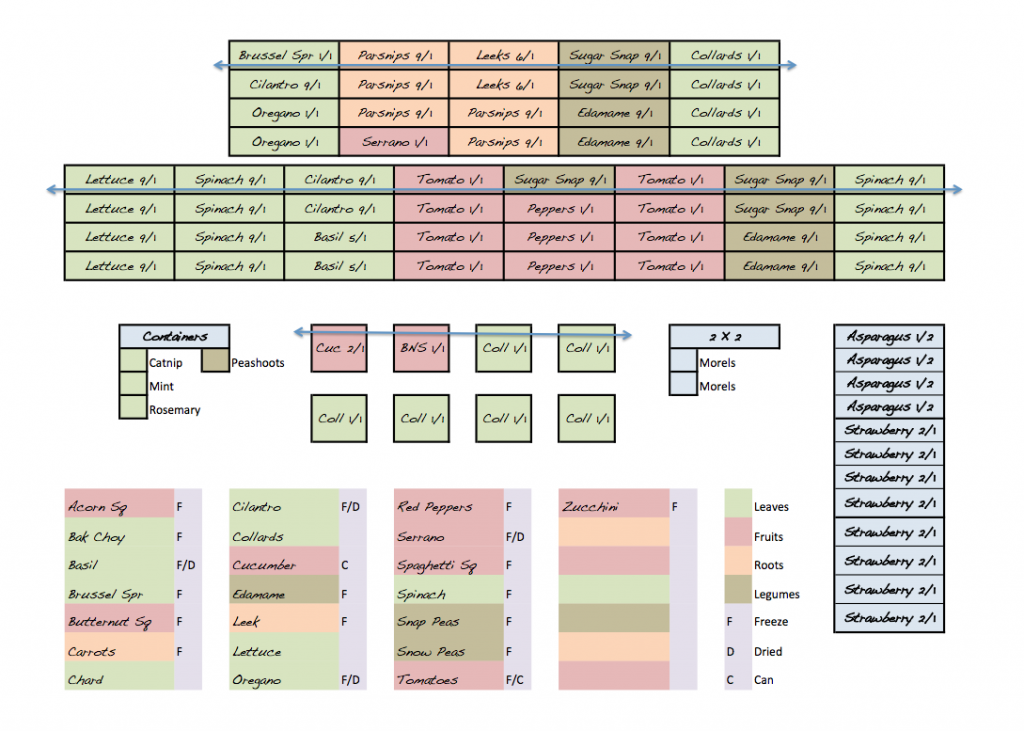 I have added permanent supports along the back portions of beds (blue lines on garden plan) by way of 6' metal fence stakes hung with rungs of coated wire to act as a ladder for climbing plants. It also works well as support for triangle shaped row covers.
I have added permanent supports along the back portions of beds (blue lines on garden plan) by way of 6' metal fence stakes hung with rungs of coated wire to act as a ladder for climbing plants. It also works well as support for triangle shaped row covers.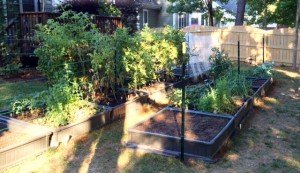 If all goes well I will be serving spinach at Christmas and collards on New Years all fresh from the garden!
If all goes well I will be serving spinach at Christmas and collards on New Years all fresh from the garden!






